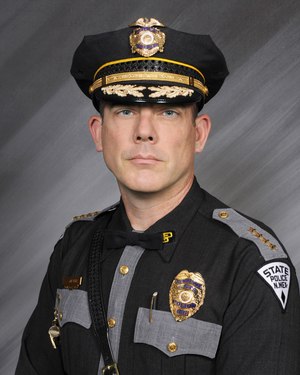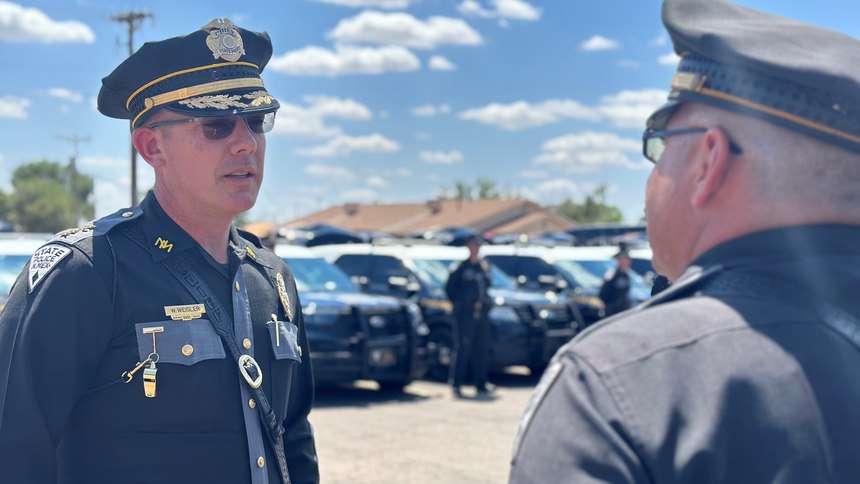The following content is part of a new Police1 initiative – the Police Leader Playbook – aimed at helping new law enforcement leaders move beyond basic management and supervision skills and become inspirational leaders with integrity and passion. Through a handful of questions presented by Police1, veteran leaders reflect on their early days in leadership roles and offer advice, while newer leaders detail their experiences taking on a new position. Email editor@police1.com to offer your insights for the Police Leader Playbook.
Chief W. Troy Weisler became the 23rd New Mexico State Police Chief on June 24, 2023. The New Mexico State Police has approximately 850 overall employees, with 640 of those being commissioned officers. The agency serves statewide, handling around 300,000 calls per year, with a state population of around 2.1 million.
Chief Weisler previously served as the Deputy Chief for Strategic Development, Special Projects, Communications and Recruiting and is a 21-year State Police veteran. He has worked in every division of the Department of Public Safety’s Law Enforcement Program, serving as deputy chief since 2021.
Weisler holds a Master of Sustainability Leadership from Arizona State University; Master of Public Administration, Justice Administration Specialization from Wayland Baptist University; and a Bachelor of Criminal Justice from New Mexico State University.

Chief W. Troy Weisler
What was the incident or person in your career who put you on the path to becoming a chief?
The person who led me to join the New Mexico State Police was my uncle, Dean Smith, who retired as a captain from the agency when I was a young boy. The specific path to becoming chief though did not really start until I was several years into my career and somewhat happened organically.
Throughout my career I was always trying to find ways to have a bigger impact, to improve how we did things, explore new possibilities, etc. Over the course of my career that led me to pursue new ventures, which included promotions and I kept moving up in the agency because I kept seeing new ways I could contribute to expanding the impact of the agency.
What do you (or did you) want to accomplish, improve or make better in your first 30 days as chief, 6 months as chief and year as chief?
I took somewhat of a “first 100 days” approach to the position when I became chief. I had been on the staff of the previous chief for several years and had a good idea of areas where we could improve and/or make changes. I felt it was important to use the natural momentum of a leadership change to reset expectations for the agency, which had been disrupted a great deal during COVID.
The first thing I wanted to accomplish was to increase communication with the field by giving them a roadmap for the future. I also implemented several things to quickly show progress in several areas as proof that the agency was moving forward and that they should want to be part of the journey.
I then traveled the state to all 12 of our districts, meeting with all members of the agency. I did this to spend one one-on-one time with them, set expectations, talk about what we were doing well, talk about what we needed to improve and remind them of the proud history and traditions of the New Mexico State Police.

Chief Weisler at a District Meeting speaking with one of his officers. (Photo/New Mexico State Police)
How are you creating an organizational culture people want to be a part of?
There are a lot of aspects to this, but the most important is to show everyone in the agency that we are all in this together. Everyone has a role to play from me as chief of the agency to the administrative assistants and mechanics working in offices across the state.
Public safety is a team sport and we need the whole team working together to accomplish the mission. A big part of that is bringing different parts of the agency together and building those relationships so everyone starts to feel like it is one big team. As we accomplish that, we then need to share that with the public, so individuals want to join the New Mexico State Police team. We are doing that through social media, community engagement and an aggressive advertising campaign on multiple platforms.
What’s your process for making major decisions?
I have always felt it was important to be involved with other groups and associations around the country because few of the challenges we face as an agency are ever actually new. Some agency somewhere has dealt with the same problem before. So, I have always leaned on mentors and friends from other similar agencies to educate myself.
I think it is important to be thorough in gathering information to make any important decision. As chief, I might not have time to know all the information, but my people should know that is the expectation. I lean on my subject matter experts, but I ask lots of questions to both educate myself, but also to ensure they are thorough. I also get the input of the chief’s staff because at the end of the day, those individuals will be the ones overseeing the implementation of major changes and they need to be bought in on the process and final decisions.
How do you show your personnel you are leading with value-based behaviors?
I think a leader must constantly display their values as well as the behaviors they expect from the troops. It can never be “Do as I say, not as I do.” It must always be a case where leadership is walking the walk. It is important to display that by getting out and spending time with the troops in the field. This is even more important when overseeing a statewide agency that has a large geographic footprint. It does not have to be all the time, but if the troops see you out getting your hands dirty or traveling to see them after a critical incident or just showing up on a swing shift, the impact of that interaction will last a long time.
Leadership lightning round
What is a leadership book, podcast or seminar you’ve found invaluable?
“Emotional Intelligence 2.0” by Dr. Travis Bradberry and Dr. Jean Greaves.
How do you organize your schedule?
I use Microsoft Outlook and schedule everything on there, including always blocking off time for follow-up meetings on important topics/projects, which can always be canceled if I end up not needing them, but this helps ensure the ball does not get dropped.
If you knew the budget request would be approved, what’s a big purchase you’d make for your department today?
A comprehensive wellness plan, including technology to track individuals’ activity and progress as well as funding for additional training facilities, physical fitness time and various health programs.
What is one way leaders can show they care about their people?
Reaching out to your people about non-work-related things such as the birth of a child, death of a family member or medical event involving themselves or a loved one.
At the end of the workday, how do you recharge?
I like to read a good book and go watch my children’s sporting events.


